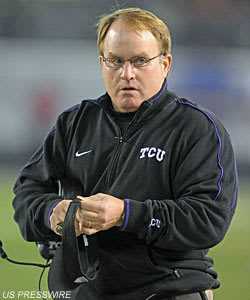Baylor, TCU take over Lone Star State

When Patrick Hudson committed to Baylor, nobody freaked out. The presses didn't stop and national sports reporters didn't much care. The lack of statements made in the mainstream media was, in fact, a statement of its own.
Baylor landing the nation's top offensive guard isn't a shocking headline. Not anymore. The No. 2 team in the country is supposed to land superstar recruits. This is where we are in 2015. The nail has become the hammer, and it's being swung with ferocity.
Advertisement
"Baylor has come so far," said four-star running back Kameron Martin, a member of the Bears' 2016 class. "I didn't know anything about Baylor when I was little because I was such a Texas Longhorns fans, like everyone else was back then. For me, it was about Jamaal Charles. Now, people look at Baylor very differently and they should … now, if you want to win and be a part of something, Baylor is the place to be."
Baylor's first 14 years in the Big 12 saw the Bears post a 43-117 record. It never won more than five games in a season and was counted on as a near-automatic win for conference rivals. These days, things are different. The Bears have reached a bowl game in each of the last five seasons and remain undefeated. The recruiting impact of the turnaround is obvious.
From 2005 until 2012, Baylor averaged a recruiting ranking of 48. The last three years? That number is 36 is trending upward. So when did it turn? Baylor head coach Art Briles hasn't pinpointed it, but he has a vague idea.
"Of course when we signed Robert [Griffin] and Kendall [Wright] in 2008, those were just hits," Briles said. "As far as when it started really turning for us with recruiting, it was after Robert's Heisman season. We built a pretty good regional brand at that time.
"I just know we're getting calls from players that would not have even answered the phone five years ago."
Family - #BackToBack @CoachArtBriles pic.twitter.com/MHSg6pIZt9- Kameron Martin (@TeamKamMartin) August 8, 2015
Just a couple of hours away from Waco, a similar situation is unfolding. TCU, which was not long ago viewed as a plucky underdog without a major conference affiliation, is now the favorite to win the Big 12 and the country's No. 3 team. Its success has snowballed on the recruiting trail since quarterback Andy Dalton, a three-star prospect with few offers, developed into a star for the Horned Frogs after signing with the program in 2006.
Head coach Gary Patterson disputes the claims that recruiting has gotten easier for him in recent years. The fact that the Horned Frogs have landed commitments from four four-star prospects in the 2016 class after hauling in a combined 18 in the 13 previous years serves as a counterpoint to his take.
"The difference in our recruiting is that the really good players used to like us but because we weren't in the SEC or the Big 12, they would tell me 'Coach, I love you but I want to play in those other conferences,' " Patterson said. "They've always come in our door. Now they just listen a little bit more. But when A&M left and went to the SEC, it brought everyone in the SEC into Texas. So, to be honest with you, I think recruiting here is a little harder now."
This is the state of college football in Texas in 2015. The once dominant Longhorns are an average team and a pair of once forgettable doormats are handing out beatdowns like bullies in a teen movie.
The turn wasn't sharp. This transformation didn't occur over night.
"It's clear that RG3 and Andy Dalton were the players on the field that inspired kids to look closer at Baylor and TCU respectively, but guys like Javonte Magee for Baylor and LaDarius Brown for TCU turned it," said Rivals.com recruiting director Mike Farrell. "Those were two top 100 in-state players with massive offers from more traditional powers. Getting them sent a message to in-state kids that you could spurn the traditional Big12 powers for these up-and-coming programs."
And spurn them they continue to do. In fact such moves are starting to happen with increasing frequency. Then, that's how change happens and how new "traditional powers" as Farrell calls them emerge.
"TCU and Baylor have staying power, yes," Farrell said. "It really all depends on head coaches staying and the offenses remaining exciting. But, yeah, I can see this lasting."


Click Here to view this Link.